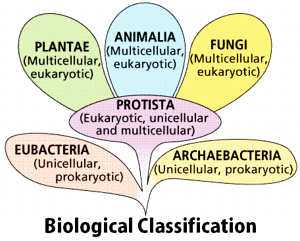Enzymes not found in:
- Fungi
- Algae
- Virus
- Cyanobacteria
The Correct Option is C
Solution and Explanation
Enzymes are biological molecules and are indeed found in all living organisms, including fungi, cyanobacteria, and algae. Viruses, however, are not considered living organisms and do not possess enzymes.
So, the correct option is (C): Virus
Top Questions on Biological Classification
Each of the following characteristics represents a Kingdom proposed by Whittaker. Arrange the following in increasing order of complexity of body organization.
A. Multicellular heterotrophs with cell wall made of chitin.
B. Heterotrophs with tissue/organ/organ system level of body organization.
C. Prokaryotes with cell wall made of polysaccharides and amino acids.
D. Eukaryotic autotrophs with tissue/organ level of body organization.
E. Eukaryotes with cellular body organization.
Choose the correct answer from the options given below:- NEET (UG) - 2025
- Biology
- Biological Classification
- Which of the following organisms is correctly matched with its kingdom?
- CUET (UG) - 2025
- Biology
- Biological Classification
- The difference in characters within very closely related groups of organisms are called:
- TS POLYCET - 2025
- Biology
- Biological Classification
- Which kingdom is included in all kingdom system classifications?
- AIIMS BSc Nursing - 2024
- Biology
- Biological Classification
- Match List I with List II
List I List II A Typhoid I Fungus B Leishmaniasis II Nematode C Ringworm III Protozoa D Filariasis IV Bacteria
Choose the correct answer from the options given below:- NEET (UG) - 2024
- Biology
- Biological Classification
Questions Asked in NEET exam
The current passing through the battery in the given circuit, is:

- NEET (UG) - 2025
- Current electricity
A constant voltage of 50 V is maintained between the points A and B of the circuit shown in the figure. The current through the branch CD of the circuit is :

- NEET (UG) - 2025
- Current electricity
- Two gases A and B are filled at the same pressure in separate cylinders with movable pistons of radii \(r_A\) and \(r_B\) respectively. On supplying an equal amount of heat to both the cylinders, their pressures remain constant and their pistons are displaced by 16 cm and 9 cm respectively. If the change in their internal energies is the same, then the ratio \(r_A / r_B\) is:
- NEET (UG) - 2025
- Thermodynamics
- Which of the following enzyme(s) are NOT essential for gene cloning?
A. Restriction enzymes
B. DNA ligase
C. DNA mutase
D. DNA recombinase
E. DNA polymerase- NEET (UG) - 2025
- Molecular Biology
- Which of the following organisms cannot fix nitrogen? A. Azotobacter
B. Oscillatoria
C. Anabaena
D. Volvox
E. Nostoc
Choose the correct answer from the options given below:- NEET (UG) - 2025
- Nitrogen Fixation
Concepts Used:
Biological Classification
The process of grouping living organisms into categories is called biological classification. The most modern 5-kingdom classification was put ahead by an eminent scientist R.H.Whittaker. The five-kingdom classification is based on the criteria like cell structure, mode of nutrition, body form, and reproduction. One of the most important characteristics of this system is that it follows the evolutionary sequence of living organisms. The organisms are classified into distinct taxa or levels like Kingdom, Phylum, Division, Class, Order, Family, Genus, and Species. The 5 kingdoms are as follows:
